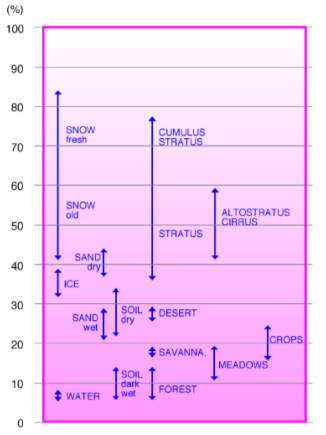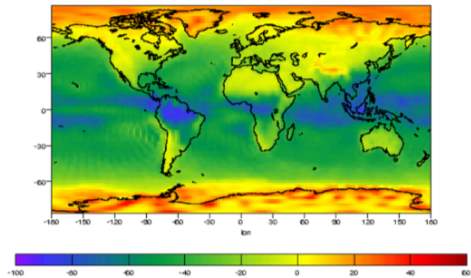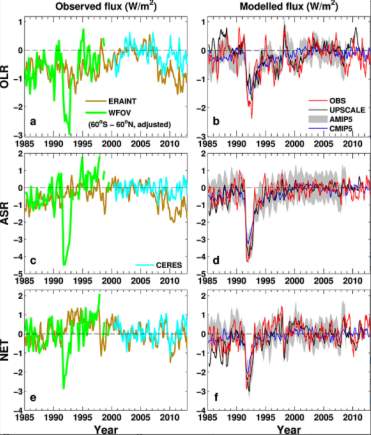Human and Natural Factors Contributing to Changes in Global Energy Balance
| ✅ Paper Type: Free Essay | ✅ Subject: Environmental Sciences |
| ✅ Wordcount: 2249 words | ✅ Published: 03 Nov 2020 |
Discuss the human and natural factors contributing to changes in the global energy balance of the Earth over the last 1,000 years.
Introduction
The global energy balance describes the balance between shortwave radiation received from the sun and outgoing longwave radiation emitted back into space (Global Physical Climatology, 1994). The absorption of solar radiation mostly occurs at the surface of the Earth, but most emission into space happens in the atmosphere (Global Physical Climatology, 1994). The amount of solar energy absorbed and emitted by the Earth fluctuates because of different human and natural influences (Srinivasan, 2008). The Earth’s climate is largely regulated by the energy balance and these fluctuations (Wild, 2013). This paper will discuss the impact of some of the most significant regulators of the energy balance, and how they have influenced climate forcings over the past 1000 years.

Figure 1: Grobe 2000, Percentage of reflected sun light in relation to the various surface conditions of the earth.
Clouds and Albedo
Clouds play a dominant role in the radiation balance of the Earth. Clouds have a cooling effect on the surface by increasing the planetary albedo and thus lessening the incoming shortwave radiation that reaches the surface (Södergren, 2018). As shown in Figure 1, in comparison to other surfaces, clouds have a high albedo and hence when present will likely reflect more shortwave radiation than the surface beneath them (Grobe, 2000). The ice particles present in clouds disperse between 20% and 90% of the sunlight that reaches them, which explains their bright white appearance (Geerts, 2002). An Earth without clouds would absorb approximately 20% more shortwave radiation from the sun than comparative present-day values (Geerts, 2002). Studies, such as those done by Tapio Schneider, have shown that a significant reduction in stratocumulus clouds could cause an astounding 8°C jump in average global surface temperatures (Schneider, 2019). However, clouds also contribute to a warming of the surface by trapping outgoing longwave radiation and radiating it back downwards (Graham, 1999). The longwave radiation absorbed as a result of cloud re-radiation warms the Earth’s surface by around 7°C, which when coupled with the cooling effect from shortwave radiation causes a net cooling of about 5°C (Rossow, 1996). In comparison to the decadal radiative forcing caused by the increase in greenhouse gases, the net cooling effect induced by clouds is around 10 times higher, and therefore changes in cloud albedo significantly affect the radiative balance, and hence climate on a global and regional scale (Mueller, 2011).

Figure 2: Norris 2016, Locations where cloudiness has changed from the 1980 – 2000, relative to the global average change.
Anthropogenic influences can alter cloud structure, formation and geography. Monitoring of the Earth’s radiation budget between 1985 and 2012 has revealed an imbalance: there has been more radiation absorbed than emitted (Orwig, 2014). Could changes in clouds explain these changes in the radiation budget? Since the 1980s, it was discovered that clouds have gotten higher (Gramling, 2016). Assuming a constant temperature in the atmosphere, an inverse relationship is distinguishable between cloud height and outgoing longwave radiation; as the height of clouds increase the amount of longwave radiation reflected back into space will decrease, and thus over time the Earth will experience rising surface temperatures (Evan, 2012). A positive feedback loop is thus created, as the primary driver of these changes to clouds is the increasing greenhouse gas concentrations, which over the past 1000 years has soared due to human activity (Johnston, 2016). In addition to cloud height, greenhouse gas emissions have caused cloud migration (Johnston, 2016). As shown in figure 2, during the latter half of the 20th century two distinct cloud migration patterns have occurred: firstly, there has been an increase of “subtropical dry zones” towards the poles, and secondly there has been a shift of mid-latitude storm tracks towards the poles (Norris, 2016). This shift in clouds could explain the changes to the radiation imbalance as when clouds shift towards the poles, more of the ocean is exposed to incoming shortwave radiation and because oceans are darker and have a lower albedo than clouds, more radiation will be absorbed, causing faster warming, and thus preserving the energy budget imbalance (Gramling, 2016).

Figure 3: Mueller 2011, Net global temperature cooling or warming induced by clouds.
In stark contrast to the oceans, polar regions near the poles have become less exposed to incoming radiation (Mueller, 2011). At the polar regions clouds tend to be thin and low-lying, thus allowing the sun’s energy to pass through them to the surface where they are absorbed, whilst simultaneously trapping heat near the surface of the ice (Wang, 2017); these cloud changes were speculated to have caused the record-breaking Greenland ice melt in 2012 (Politics & Government Business, 2013). As ice retreats, such as in Greenland, the presence of open water increases, favouring cloud formation and therefore further amplifying sea ice melting in a positive feedback loop (Huang, 2019). This phenomenon is shown in figure 3 by the red areas near the poles (Mueller, 2011). It can consequently be argued that the increase in the global energy surplus in the last century has been concurrently caused and amplified by clouds.
Greenhouse Gases, Aerosols and Anthropogenic Influences

Figure 4: Crowley 2000, Greenhouse gas forcings over the past 1000 years and projected forcing
As depicted in figure 4 by the sharp peak around 1850, warming over the past century is unprecedented in the past 1000 years (Crowley, 2000). Infact, 41%-64% of temperature fluctuations between 1000 and 1850 can be accounted for by external factors, such as volcanism and solar irradiance (Crowley, 2000). However, over the last 100 years global temperatures have risen by 0.74°C, and most of this change can be attributed to increasing greenhouse gas emissions and their effect on the energy budget (European Environment Agency, 2006). Carbon dioxide forces an energy imbalance by absorbing thermal infrared energy radiated by the surface (Schaller, 2013). Carbon dioxide partially traps outgoing longwave radiation in the atmosphere, therefore radiation that previously would’ve left the atmosphere is now absorbed (Pease, 1987). Anthropogenic carbon dioxide emissions have been almost exponentially increasing since the Industrial Revolution, and thus observed warming of around 0.7°C between 1880 and 2003 as response to nearly 1 W/m2 of forcing can be argued to be partially caused by Co2 emissions (Wang, 2016). In addition to carbon dioxide, water vapour also plays a part in this energy balance change. Water vapour absorbs 60% of outgoing longwave radiation, which in comparison to the 26% absorbed by carbon dioxide, is significantly more potent (Kleidon, 2008). Warming creates a positive feedback of increased water vapour, as when surface temperature increases so does ocean water evaporation – intensifying the greenhouse effect further (Jacob, 2001). However, through the process of latent heating, when water vapour condenses it forms clouds creating a negative feedback as, since previously stated, clouds have a dominant cooling effect, reducing the disparity between incoming and outgoing radiation (Earth Labs, 2019).

Figure 5: Allan 2014, Changes in outgoing longwave radiation and absorbed shortwave radiation and their net effect
Another factor contributing to changes in the energy budget are the presence of aerosols. Although naturally occurring from volcanic eruptions and wildfires, the presence of aerosols has been enlarged by anthropogenic sources such as coal-fired power plants and vehicles (Russell, 2007). Aerosols reduce the amount of sunlight reaching the surface and is said to be the primary cause of ‘global dimming’ (Hansen, 2011). While greenhouse gases are thought to proliferate warming, aerosols do the opposite (Dallafior, 2015). Intense volcanic eruptions, such as Pinatubo, disperse enough aerosols into the atmosphere to cancel out greenhouse warming resulting from a doubling of carbon dioxide (Dickinson, 1996). Moreover, the addition of aerosols in the troposphere because of fossil fuel combustion may already be countering up to half of greenhouse-gas warming (Dickinson, 1996). The cooling influence of the 1991 Mt. Pinatubo eruption, which injected around 20 Tg of SO2 into the stratosphere, is estimated to be 0.5K, which was ultimately caused by the net energy balance deficit which ensued (Swingedouw, 2017). This change is illustrated in figure 5 by the peak occurring at 1991, demonstrating the dramatic impact aerosols can have on the energy balance (Allan, 2014). Therefore, although the energy budget is currently imbalanced, without the presence of aerosols this disparity could be substantially larger.
Conclusion
The last 1000 years has seen many changes to the global energy balance, however it is evident that the most profound changes have occurred over the past 100 years (Crowley, 2000). The net impact of human activity such as higher concentrations of carbon dioxide and aerosols has caused a rise in surface temperatures of the earth by 0.70C over the past century (Srinivasan, 2008). Research into the global energy balance has enlightened researchers with innovative methods in which they can counteract global warming such as artificially injecting aerosols into the stratosphere to mimic volcanic eruption cooling and engineering of brighter clouds to increase reflection of infrared radiation (Baughman, 2012). Further investigation into the interactions between Earth and solar energy could help to unlock even more methods to offset climate change, before the devastating ramifications of global warming are experienced.
Bibliography
- Chapter 2 The Global Energy Balance. (1994). Global Physical Climatology, pp.18-39.
- Srinivasan, J. “Climate Change, Greenhouse Gases and Aerosols.” Resonance 13.12 (2008): 1146-155. Web.
- Wild, Martin, Doris Folini, Christoph Schär, Norman Loeb, Ellsworth Dutton, and G. König-Langlo. “The Global Energy Balance from a Surface Perspective.” Climate Dynamics 40.11-12 (2013): 3107-134. Web.
- Södergren, A., Helena McDonald, and Adrian Bodeker. “An Energy Balance Model Exploration of the Impacts of Interactions between Surface Albedo, Cloud Cover and Water Vapor on Polar Amplification.” Climate Dynamics 51.5-6 (2018): 1639-658. Web.
- Grobe, H. (2000). File:Albedo-e hg.png – Wikimedia Commons. [online] Commons.wikimedia.org. Available at: https://commons.wikimedia.org/wiki/File:Albedo-e_hg.png [Accessed 11 Dec. 2019].
- Geerts, B. (2002). Do clouds warm or cool the climate? [online] Www-das.uwyo.edu. Available at: http://www-das.uwyo.edu/~geerts/cwx/notes/chap09/rossow.html [Accessed 11 Dec. 2019].
- Schneider, Tapio M., Colleen M. G. Kaul, and Kyle G. Pressel. “Possible Climate Transitions from Breakup of Stratocumulus Decks under Greenhouse Warming.” Nature Geoscience 12.3 (2019): 164-68. Web.
- Graham, S. (1999). Clouds & Radiation Fact Sheet. [online] Earthobservatory.nasa.gov. Available at: https://earthobservatory.nasa.gov/features/Clouds [Accessed 11 Dec. 2019].
- Rossow, W. (1996). NASA GISS: Science Briefs: Cloud Climatology: Net Effect on Climate. [online] Giss.nasa.gov. Available at: https://www.giss.nasa.gov/research/briefs/rossow_01/neteffect.html [Accessed 11 Dec. 2019].
- Mueller, Richard, Jörg Trentmann, Christine Träger-Chatterjee, Rebekka Posselt, and Reto Stöckli. “The Role of the Effective Cloud Albedo for Climate Monitoring and Analysis.” Remote Sensing 3.11 (2011): 2305-320. Web.
- Orwig, J. (2014). Changes in Earth’s Radiation Balance Between 1985 and 2012 – Eos. [online] Eos. Available at: https://eos.org/research-spotlights/changes-earths-radiation-balance-1985-2012 [Accessed 11 Dec. 2019].
- Gramling, Carolyn. “Cloud Patterns Are Shifting Skyward and Poleward, Adding to Global Warming.” Science (2016): Science, 07/12/2016. Web.
- Evan, Amato T., and Joel R. Norris. “On Global Changes in Effective Cloud Height.” Geophysical Research Letters 39.19 (2012): N/a. Web.
- Johnston, I. (2016). The very worrying effect climate change is having on clouds. [online] The Independent. Available at: https://www.independent.co.uk/environment/climate-change-clouds-higher-sky-towards-poles-greenhouse-gases-global-warming-volcanoes-a7131216.html [Accessed 11 Dec. 2019].
- Norris, J. R. et al. (2016) Evidence for climate change in the satellite cloud record, Nature, doi:10.1038/nature18273
- Wang, Wenshan, Zender, Charles S., Davis, Steven, and Rignot, Eric. Contributions of Clouds to Greenland’s Surface Melt (2017): ProQuest Dissertations and Theses. Web.
- “Climate Modeling; Thin, Low Arctic Clouds Played an Important Role in Widespread 2012 Greenland Ice Sheet Melt.” Politics & Government Business [Atlanta] 2013: 86. Web.
- Huang, Yiyi, Xiquan Dong, David A. Bailey, Marika M. Holland, Baike Xi, Alice K. DuVivier, Jennifer E. Kay, Laura L. Landrum, and Yi Deng. “Thicker Clouds and Accelerated Arctic Sea Ice Decline: The Atmosphere‐Sea Ice Interactions in Spring.” Geophysical Research Letters 46.12 (2019): 6980-989. Web.
- Crowley, Thomas J. “Causes of Climate Change over the past 1000 Years.” Science 289.5477 (2000): 270-77. Web.
- European Environment Agency. (2006). How is climate changing and how has it changed in the past?. [online] Available at: https://www.eea.europa.eu/themes/climate/faq/how-is-climate-changing-and-how-has-it-changed-in-the-past [Accessed 12 Dec. 2019].
- Schaller, N., J. Wild, M. Knutti, and R. Cermak. “The Sensitivity of the Modeled Energy Budget and Hydrological Cycle to CO2 and Solar Forcing.” Earth System Dynamics 4.2 (2013): 253-66. Web.
- Pease, Robert W. “The Average Surface Temperature of the Earth: An Energy Budget Approach.” Annals of the Association of American Geographers 77.3 (1987): 450-61. Web.
- Wang, Weile, and Ramakrishna Nemani. “Dynamic Responses of Atmospheric Carbon Dioxide Concentration to Global Temperature Changes between 1850 and 2010.” Advances in Atmospheric Sciences 33.2 (2016): 247-58. Web.
- Kleidon, A. (2008). Energy Balance. Encyclopedia of Ecology, pp.1276-1289.
- Jacob, D. (2001). The role of water vapour in the atmosphere. A short overview from a climate modeller’s point of view. Physics and Chemistry of the Earth, Part A: Solid Earth and Geodesy, 26(6-8), pp.523-527.
- Earth Labs. (2019). Climate and the Biosphere. 2A: Solar Energy and the Water Cycle. [online] Available at: https://serc.carleton.edu/eslabs/weather/2a.html [Accessed 12 Dec. 2019].
- Russell, R. (2007). Aerosols, Cloud Nucleation and Global Dimming – Windows to the Universe. [online] Windows2universe.org. Available at: https://www.windows2universe.org/earth/Atmosphere/aerosol_cloud_nucleation_dimming.html [Accessed 12 Dec. 2019].
- Hansen, J., M. Sato, P. Kharecha, and K. Von Schuckmann. “Earth’s Energy Imbalance and Implications.” Atmospheric Chemistry and Physics 11.24 (2011): 13421-3449. Web.
- Dallafior, T. N., D. Folini, R. Knutti, and M. Wild. “Dimming over the Oceans: Transient Anthropogenic Aerosol Plumes in the Twentieth Century.” Journal of Geophysical Research: Atmospheres 120.8 (2015): 3465-484. Web.
- Dickinson, Robert. “Climate Engineering a Review of Aerosol Approaches to Changing the Global Energy Balance.” Climatic Change 33.3 (1996): 279-90. Web.
- Swingedouw, Didier, Juliette Mignot, Pablo Ortega, Myriam Khodri, Martin Menegoz, Christophe Cassou, and Vincent Hanquiez. “Impact of Explosive Volcanic Eruptions on the Main Climate Variability Modes.” Global and Planetary Change 150 (2017): 24-45. Web.
- Allan, Richard P., Chunlei Liu, Norman G. Loeb, Matthew D. Palmer, Malcolm Roberts, Doug Smith, and Pier‐Luigi Vidale. “Changes in Global Net Radiative Imbalance 1985–2012.” Geophysical Research Letters 41.15 (2014): 5588-597. Web.
- Baughman, Gnanadesikan, Degaetano, and Adcroft. “Investigation of the Surface and Circulation Impacts of Cloud-Brightening Geoengineering.” Journal of Climate 25.21 (2012): 7527-543. Web.
Cite This Work
To export a reference to this article please select a referencing stye below:
Related Services
View allDMCA / Removal Request
If you are the original writer of this essay and no longer wish to have your work published on UKEssays.com then please click the following link to email our support team:
Request essay removal



